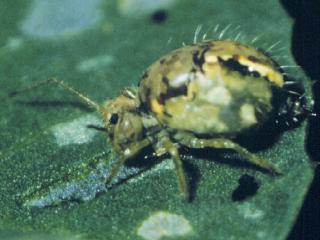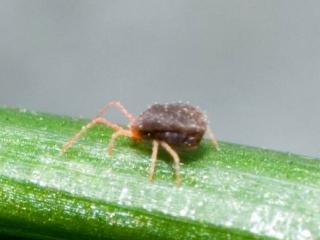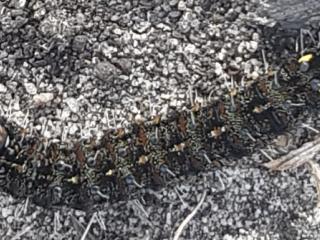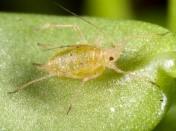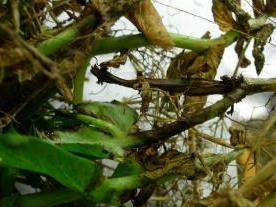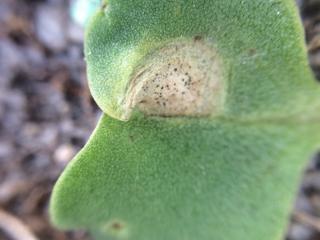Be aware of mites and lucerne flea as crops germinate
- Bruce Rock
- Quairading
- Kojonup
- Kendenup
- Arthur River
David Stead (Anasazi Agronomy) reports that there are small pockets of lucerne flea in dry sown cereal crop seedlings at Bruce Rock and Quairading.
Alec Smith (Kojonup Agricultural Supplies) reports bryobia mite feeding damage in canola near Kojonup. He has also seen redlegged earth mites (RLEM) in crops from Kendenup to Arthur River.
With the recent rainfall needed by the majority of crops to germinate across the grainbelt, it is important to consider the agronomic implications of this type of start to the season and whether further insecticides are required for particular pests.
RLEM are expected to pose an immediate risk to seedlings emerging now (especially canola) as they had already hatched before last week’s rain. Lucerne flea may pose a risk in the near future as they may only be hatching now after recent soaking rains.
Last year many growers were caught out with high levels of lucerne flea damaging crops in June and July because the hatching of eggs was delayed probably beyond the window of insecticide residual activity.
Managing mites and lucerne flea
If crops were sprayed more than two weeks ago they may be susceptible now to mites and lucerne flea and a follow up insecticide may be required.
Insecticides will not kill RLEM eggs so it should not be assumed that a pre-sowing insecticide application has killed all mites that could be present during crop germination. A follow up spray may be required depending on RLEM numbers and crop damage.
Lucerne flea have a high natural tolerance to synthetic pyrethroids so avoid insecticides from this group.
For more insecticide information refer to DPIRD’s 2019 Autumn/Winter Insecticide Guide.
Growers and consultants are urged to apply integrated pest management (IPM) strategies when managing RLEM. These strategies include; identifying mites, rotating different chemical groups and reserving co-formulations or chemical mixtures only for situations where damaging levels of RLEM and other insect pests are present. For more IPM information see DPIRD’s Prevent redlegged earth mite resistance page and GRDC’s Resistance management strategy for the red legged earth mite in Australian grains and pastures fact sheet.
RLEM surveys for resistance will again be undertaken in 2019 for WA properties. DPIRD is particularly interested in testing mites from any properties with synthetic pyrethroid (SP) and omethoate spray failures. To enquire and arrange for resistance testing contact Svetlana Micic, Albany DPIRD on +61 (0)8 9892 8591.
For more information about diagnosing and managing mites refer to the departments;
For more information on invertebrate insects contact Dustin Severtson, Development Officer, Northam on +61 (0)8 9690 2160 or Svetlana Micic, Research Officer, Albany on +61 (0)8 9892 8591.
Pasture day moth caterpillars
- Busselton
Graham Mussell (Graham Mussell Consulting) reports finding one pasture day moth caterpillar per square metre, in a reseeded pasture paddock south of Busselton. This paddock had a capeweed base before a knockdown spray. The caterpillars are feeding on what is left of the capeweed and as yet have not damaged the emerging sub clover and grass. The paddock will continue to be monitored as although the pasture day moth caterpillars mainly feed on broadleaf species in pasture, they may damage emerging seedling crops when in large numbers and especially when broadleaf weeds are removed with herbicides.
Pasture day moth larvae are dark brown with yellow and reddish orange markings. They have two prominent yellow spots near the end of the body and an orange-black head. Pasture day moth caterpillars remain on plants during the day. The caterpillars grow to about 60mm long before commencing to dig holes in the ground as they get ready to pupate. The moths have brown and yellow patterns on their wings and may be seen flying by day (as the name implies). The insect has only one generation per year.
Pasture day moth caterpillars are not usually considered a pest as they prefer to feed on capeweed, erodium and other broadleaved weeds.
Pasture day moth caterpillars are easily controlled by insecticides.
For more information pasture day moths refer to DPIRD’s Diagnosing pasture day moth damage page.
For more information contact Alan Lord, Technical Officer, South Perth on +61 (0)8 9368 3758 or Dustin Severtson, Development Officer, Northam on +61 (0)8 9690 2160.
First signs of low-level resistance evolving to Transform™ detected in isolated WA green peach aphid populations
Evidence of the green peach aphid (Myzus persicae, GPA) evolving resistance to sulfoxaflor (Transform™) has been confirmed for the first time in Australia, after a small number of aphid populations from Esperance, Western Australia were shown to have reduced sensitivity to the insecticide.
Details of the detection
Five GPA populations collected from Esperance, WA were tested in the laboratory for sensitivity shifts to sulfoxaflor. A reduction in sensitivity to the insecticide was detected in four populations, and this was shown to persist after the colonies were maintained in the laboratory for several generations. This suggests that there is a genetic basis to these sensitivity shifts.
The discovery was made through collaborative research between cesar, CSIRO and DPIRD. The research was the result of a co-investment by GRDC and Corteva Agriscience™.
Why this detection is important
Sulfoxaflor is registered for use to control GPA in in broadacre canola crops. While GPA can inflict direct feeding damage when in high numbers, controlling the aphids is usually undertaken to prevent turnip yellows virus (TuYV) spread.
GPA has evolved varying degrees of resistance to other alternative registered chemistries in canola -- sulfoxaflor is the only remaining active registered in canola available for use as a foliar spray that is still reliably effective.
In Australia, GPA is already known to have widespread resistance to four different chemical mode of action group – synthetic pyrethroids, organophosphates, carbamates, and neonicotinoids. To view resistance maps click here.
GPA has evolved high level resistance to synthetic pyrethroids (e.g. alpha-cypermethrin) and carbamates (e.g. pirimicarb) and results in complete insecticide ineffectiveness and control failures.
The evolution of resistance to organophosphates in GPA is more complicated. The mechanism behind the resistance is unusual because it can be ‘switched on’ in response to insecticide exposure. Using organophosphates against GPA is therefore risky; it could be effective in some instances but not others.
The resistance mechanism behind neonicotinoid resistance is also not straightforward. Only one form of neonicotinoid resistance, known as metabolic resistance, has been found in Australian GPA. This confers low-level resistance, which means growers will not experience complete control failures or a dramatic loss of efficacy of neonicotinoid seed treatments at this stage.
However, while neonicotinoids are still a reliable tool for GPA management, in canola they are restricted to use as a seed dressing, providing protection at the early stages of crop growth. As TuYV can impact canola yield if the infection occurs up until the rosette stage, effective foliar insecticides are needed in the toolbox for high-risk virus years.
In short, if resistance to sulfoxaflor spreads or evolves to a higher level, it would be problematic in seasons that favour spread of TuYV.
Management advice for growers and advisors
To limit the spread and curb the further evolution of resistance, it is critical that sulfoxaflor is used judiciously and as part of a sound insecticide resistance management strategy. For more information refer to GRDC’s Resistance Management Strategy for the Green Peach Aphid in Australia Grains.
Given that there are limited alternative mode of action groups to rotate for GPA control, non-chemical approaches to management are a must, especially in TuYV low-risk years.
Green bridge control and deterring aphid landings during autumn by sowing into standing stubble are two preventive tactics that growers can use to reduce reliance on insecticides.
Conserving beneficial natural enemies of aphids such as spiders, predatory mites, ladybird beetles, lacewings, hoverflies and parasitoid wasps, through use of ‘soft’ chemistries will also help to reduce reliance on insecticides.
If considering spraying, ensure correct ID of the aphids, as cabbage aphid and turnip aphid which can colonise young canola but have not evolved insecticide resistance, can be mistaken for GPA.
If spraying with sulfoxaflor is warranted, adhere to the following guidelines:
- Ensure optimum coverage as the insecticide will not move downwards in the plant, only upwards. Use high water volumes and ensure correct nozzle type and ground speed.
- If GPA are colonising older leaves, spray canola before the canopy closure
- Do not cut label rates – lower rates may not provide control and will increase the selection pressure for resistance to sulfoxaflor.
Growers are asked to keep a close eye on establishing canola crops this year and to contact cesar on +61 (0)3 9349 4723 if aphids survive a Transform™ application.
For more information contact Dr Paul Umina, Director, cesar on +61 (0)405 464 259.
Acknowledgements: Dr Rob Annetts (Corteva Agriscience™), Jenny Reidy-Crofts (CSIRO), Dr James Maino (cesar), Emma Clarke (DPIRD), Alice Butler (DPIRD) and several agronomists for aphid collections.
This article was sourced from cesar.
WA growers that have received rainfall are advised to sow their field peas
This season has been dry and many places have experienced a cold May. These factors have resulted in a very slow maturation of the blackspot fungal fruiting bodies on previous season’s field pea stubbles at many locations in WA this year.
As rainfall has fallen in most WA locations since last Friday it is recommended that growers sow their field peas irrespective of their blackspot risk.
Field pea sown now at Boyup Brook, Gairdner, Jacup, Katanning, Mount Barker and Narrogin will have a low blackspot risk as fruiting bodies have matured and more than 50% of the spores have already been released.
For Bencubbin, Cunderdin, Dalwallinu, Dowerin, Kondinin, Lake King, Merredin, Mingenew, Moora, Mullewa, Newdegate, Salmon Gums and Tammin the agronomic sowing window closes from mid-June onwards and there is a yield loss penalty for late sowing of field pea. At these locations you should try and sow field pea as soon as you can get into these paddocks. The blackspot risk is high for some of these locations.
For more details on the latest Blackspot Manager forecast refer to the department's Field pea blackspot sowing guide for Western Australia - 10 June 2019.
Growers and consultants can regularly check their locations blackspot risk as updated forecasts are available weekly at the department’s Blackspot in field peas disease forecast 2019 page.
For more information on blackspot refer to the department’s Diagnosing blackspot in field peas page.
To subscribe to the free blackspot SMS service, text 'blackspot', your name and nearest weather station to 0475 959 932 or email Blackspot.Manager@dpird.wa.gov.au to subscribe to the direct email service.
For more information on blackspot in field peas or the forecasts contact Jean Galloway, Research Officer, Northam on +61 (0)8 9690 2172.
Canola downy mildew
-
Kojonup
Alec Smith (Kojonup Agricultural Supplies) reports finding downy mildew on OP TT canola varieties west of Kojonup despite previously dry conditions. The canola plant growth stage in this area ranges from seedlings to 4-6 leaf stage with older leaves being infected. After recent rainfall seedlings are expected to be vulnerable to infection and disease spread through secondary infection is a concern.
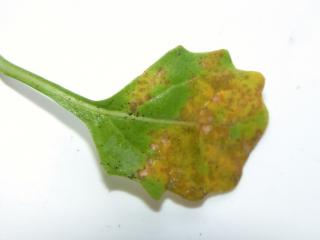
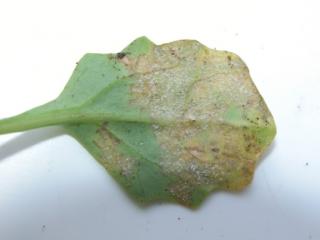
Plant pathologist Ravjit Khangura (DPIRD) says that the disease mainly affects young cotyledons, true leaves and expanded leaves, however the latter are usually less severely affected.
Symptoms of downy mildew typically appear as yellowed cotyledons and lower leaves. Older leaves display angular yellow lesions on the upper leaf surface. Sometimes the lesions appear as creamish, circular to irregular spots of varying sizes on the upper leaf surface that turn brownish over time.
Examination of the underside of these leaves often shows a corresponding patch of white fluffy growth, although this can become less apparent with age. Severely affected cotyledons shrivel up and senesce prematurely.
While some early seedling mortality may occur, canola plants usually overcome the disease once they reach the cabbage stage. Infected plants will exhibit slower growth earlier in the season due to a combination of cold weather and presence of disease. Plants grow away from disease as they get older and as the weather warms up during spring.
Disease is generally favoured by cool (15-18◦C) wet conditions coupled with high humidity. Under such conditions, disease spreads very rapidly.
Downy mildew is either soil borne, seed borne or requires a green bridge for carry over. Once the primary lesions are formed on the underside of the leaves, secondary spread of the disease occurs via the airborne spores formed in the primary lesions. Disease epidemics are sporadic, therefore developing control strategies against downy mildew can be very challenging.
Most of the current canola varieties are susceptible to downy mildew.
Only one copper based fungicide (Cung Fu 350SC®) is registered for downy mildew in canola and needs to be applied as per product label. Ravjit says her previous research on fungicidal control of downy mildew has shown that foliar fungicides are usually effective against downy mildew if applied before the onset of the disease. The economic benefit is unlikely if sprayed after severe infection. Fungicide seed dressings containing metalaxyl (MaximXL®) may provide some protection against downy mildew if the disease pressure is low to moderate.
More information about this disease can be found at the department’s Diagnosing downy mildew in canola page.
For more information contact Ravjit Khangura, Research Officer, South Perth on +61 (0)8 9368 3374.
Latest update on blackleg spore shower risk forecast
Growers are advised to check the department’s latest blackleg risk forecast (current to 10 June) for their area as canola crops emerge.
The DPIRD blackleg sporacle model predicts the onset of blackleg ascospore release from canola stubble for 26 canola growing districts of Western Australia using the latest weather data from the nearest weather stations to these locations.
The latest forecast (current to 10 June) is predicting that the risk of blackleg is high or moderate to high for all southern shires and most central shires. This means that blackleg spores are mature, or close to being mature, in these shires and will begin spreading from stubble to canola seedlings now or in the near future.
As per the model’s latest prediction, spore showers are already occurring in some of the lower great southern and south coastal areas, including Narrogin, Darkan, Mount Barker, Jerramungup and Esperance downs.
Regularly visit the department's Canola blackleg spore maturity forecast for Western Australia page to find out the latest forecast for your location. The blackleg spore shower risk will change each week as the season progresses depending upon the weather conditions in the coming weeks, therefore, growers are urged to check the weekly updates.
Dry seasonal conditions have delayed both the blackleg spore maturity and crop emergence meaning that there is high risk of coinciding spore showers with the most susceptible stage of the crop. Growers are urged to reassess their risk in the light of current weather conditions and apply appropriate in-crop control measures to curtail the risk of yield loss. For further details on blackleg management and current blackleg ratings refer to GRDC’s Blackleg Management Guide (2019 autumn variety ratings) and Plan ahead to fight blackleg in canola this season media release.
The recently released BlacklegCM app can be downloaded onto tablets from the apple store or Google Play and used to support decisions that growers are making now on blackleg fungicide management options. Developer of the app, Art Diggle (DPIRD) says that the app allows the user to enter information specific to their paddocks and circumstances. For more information refer to the department's BlacklegCM page or contact Art Diggle, Senior Research Officer, South Perth on +61 (0)8 9368 3563.
For more information about blackleg in canola and the blackleg sporacle model contact Ravjit Khangura, Research Officer, South Perth on +61 (0)8 9368 3374 or Kawsar Salam, Research officer, South Perth on +61 (0)8 9368 3104.

